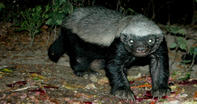
Name
Honey badger [Mellivora capensis]Appearance
The honey badger is characterised by its black pelt and broad streak of grey hair running from its head down to its tail. Their short, stout legs and low-lying bodies are perfectly designed for digging into the dry bushveld ground.
From the shoulder, the honey badger stands at a height of 250 mm high and they weigh around 12 kgs. Although they are mainly terrestrial, they will climb trees to reach beehives. They move in a jog-trotting motion and are known to relentlessly track their prey until it has been run to the ground.
Honey Badger Diet
The honey badger is a carnivore and feeds on other smaller terrestrial bound animals such as snakes, rodents and scorpions. Sometimes, they scavenge off the kills of other larger predators found in South Africa. How often they consume honey is unknown. They are known to follow the honeyguide bird to track down beehives, after which the honey badger rewards the bird with honeycomb scraps.Honey Badger Breeding
The honey badger can breed all year round, producing 1 or 2 offspring at a time. Research done in the southern Kalahari Desert in South Africa has found that cubs become independent from their mothers after 14 months. This contrasts greatly with the Eurasian badger which becomes independent after just 3 months.Honey Badger Behaviour
The honey badger is known for being brave and fierce, displayed in its will to fight just about any animal.
The first game warden of the Kruger Park, James Stevenson-Hamilton, recorded two separate incidents where he witnessed honey badgers attacking the scrotums of a wildebeest and waterbuck. Honey badgers are known as foragers, as they keep their heads to the ground sniffing out the trails of their prey.
They are also solitary hunters. Honey badgers in the southern Kalahari change from being nocturnal in summer to diurnal in winter. However, where there is a human presence, the honey badgers will become mainly nocturnal.
Honey Badger Habitat
Honey badgers are found in a variety of environments around South Africa but tend to avoid extreme desert climates and areas with more than 2000 mm of rainfall a year.Predators
The honey badgers often fall prey to lions and leopards in South Africa. Their stark black and white coats are believed to serve as a warning to predators of their vivacity and strength.Interesting Facts
The honey badger has a high tolerance and immunity to snake venom, scorpion and bee stings. After being bitten by the highly cytotoxic puff adder snake, the honey badger expressed pain but showed a full recovery after five hours.
The honey badger’s strong immunity against venom is most likely caused by the numerous bites received while preying on poisonous snakes from South Africa. Honey badger cubs are not allowed to catch any poisonous snakes until they have learnt the correct skills and coordination from their mother.
There have been a few cases where honey badgers have been stung to death by bees in commercial apiaries.
 Mel means ‘honey’ and voro means to ‘devour’ and the genus refers to the honey badger’s habit of eating bee larvae and honey. Cont...
Mel means ‘honey’ and voro means to ‘devour’ and the genus refers to the honey badger’s habit of eating bee larvae and honey. Cont... The honey badger has a well-developed reputation for its ferocity. It is a relatively small animal with the temperament of a large one and e...
The honey badger has a well-developed reputation for its ferocity. It is a relatively small animal with the temperament of a large one and e...